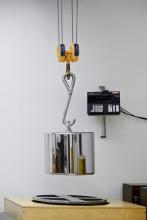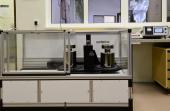
Name of Standard: National standard of large weight 500 kg
Code designation: ECM 120-2/09-046
Year of announcement: 2009
Department: CMI RI Jihlava
Guarantor: Lukáš Běhal, Pavel Pánek (2009 – 2011)
Manufacturer: Häfner Gewichte GmbH
Technical specification of the reference standard
| Conventional mass | 500 kg +0.50 g |
Uncertainty | 0,25 g (where k = 2) |
| Material | X12CrNiSi2521 |
| Density | 8050 kg.m-3 ± 50 kg.m-3 |
| Shape | roller with rounded edges (eye for handling, fitted bottom) |
| Dimensions | diameter = 450 mm, height = 400 mm |
| Surface roughness | Rz = 3 µm |
| Hardenss | > 140 HB |
Magnetic susceptibility | < 0,01 |
| Inventory number | 601301 |
Unlike some fields of measurement, in the field of mass measurement there is a multi-stage continuity scheme that determines how to ensure the uniformity and accuracy of mass measurement over the entire range used and on all series of secondary standards and on all accuracy classes of working gauges. This is due to the way in which the unit of mass is defined by the international prototype - only one standard has the value of 1 kg, from which the whole standardisation is derived. Hence the need to implement with the highest achievable accuracy at the primary level. The most suitable solution was the purchase of a 500 kg cylindrical weight made of X12CrNiSi2521 alloy, which was declared the state standard of large mass in 2009 under the leadership of Pavel Pánek, the guarantor.
The standard is defined as an E2 class weight of 500 kg, which was calibrated in 2009 at PTB with a conventional weight value of 500 kg + 0.50 g with an uncertainty (k=2) of 0.25 g.
The procedure of tying to 50 kg and 10 kg weights was chosen with the control of tying to the state standard of 1 kg weight and the value of the indicated PTB. For this purpose, Sartorius mass comparators, CC50001S-L with a maximum weighing capacity of 51 000 g, a fraction of 1 mg and a standard deviation of repeatability < 5 mg and Metttler Toledo, KC500-1 with a maximum weighing capacity of 600 kg, a fraction of 0.1 g and a standard deviation of repeatability < 0.3 g were chosen as the transfer device. Unit transfer is carried out using a set of 10 kg and 50 kg primary standards, using a special fixture.
An important factor for correct unit transfer is to maintain the standard deviations of repeatability of the selected mass comparators within the declared value. It is possible to keep the value within the range of 1.24 mg to 2.3 mg for 50 kg and 0.23 g to 0.12 g for 500 kg. The chosen method of unit transfer consists of a direct comparison on the above-mentioned mass comparators by the ABA method (r1t1r2) in 10 cycles. The resulting difference in indication is given by
:
The resulting deviation is based on the relationship:
Where stands for:
ΔIi | ......…..... | difference indications, |
mcr | ......…..... | the conventional weight of the reference weight, |
C | ......…..... | value of the correction for air lift, |
mNt | ......…..... | the nominal value of the weight to be tested. |
Correction for air lift:
Where stands for:
ra | ......…..... | air density |
r0 | ......…..... | reference air density equal to 1.2 kg m-3 |
rt | ......…..... | density of the reference weight of mass mr |
rr | ......…..... | density of experienced weights |
Correction for air lift is always applied.
In 2013 we use a new program to calibrate the weights, with the help of its evaluation and the writing of all variables in the uncertainty subcomponents we have moved to the PTB uncertainty.
Determination of the combined standard uncertainty:
Where stands for:
......…..... | standard uncertainty of the weighing process, | |
u(mcr) | ......…..... | the uncertainty of the reference weight, |
ub | ......…..... | uncertainty of correction for air lift, |
uba | ......…..... | uncertainty caused by the resolution of the digital scale display. |
Resulting determination of the conventional weight value in 2013:
Nominal value | Marking / Characteristics | Conventional weight value | Uncertainty |
500 kg |
| 500 kg+430 mg | 240 mg |
Etalon participated in the international comparison EUROMET Comparison of 500 kg standard (Euromet.M.M-S1) and several two-sided comparisons.
The standard is stored in a cassette (special box) with a padded bottom and arrangements for centering the weights in the weight laboratory. The standard handling device is a special hook made of polished stainless steel to minimize abrasion of the handling eye. The transport device is a transport box.



